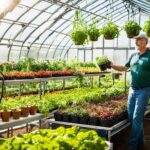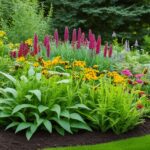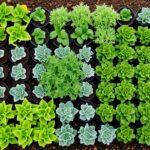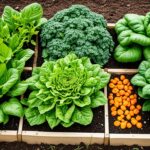Sustainable gardening practices
Greenhouse Gardening: Extend Your Growing Season
Are you ready to unlock the secrets of year-round gardening? Greenhouse gardening could be the game-changer you’ve been searching for. By creating a controlled environment, greenhouses can extend your growing season by up to 60%. This lets you enjoy fresh produce long after your outdoor garden has gone dormant. But is this sustainable approach to gardening truly worth the investment?
Key Takeaways
- Greenhouse gardening can extend your growing season by up to 60%
- Greenhouses provide a controlled environment to protect your plants from harsh weather and pests
- Unheated and heated greenhouses both offer unique benefits for year-round gardening
- Hoop houses and row covers can further extend your growing season at home
- Greenhouse gardening allows you to grow a wider variety of plants, including herbs and annuals
Introduction to Greenhouse Gardening
Greenhouse gardening opens up new possibilities for extending your growing season and boosting your crop yields. It lets you create the perfect conditions for your plants to grow, no matter the weather outside. Whether you pick an unheated or heated greenhouse, the benefits are many and can change your gardening for the better.
Benefits of Using a Greenhouse
Growing in a greenhouse brings many benefits that can change your gardening. A greenhouse advantages include controlling temperature, humidity, and light for your plants. This controlled environment keeps your crops safe from pests, bad weather, and losing nutrients, leading to healthier, more productive plants.
Extending the Growing Season by Up to 60%
One big plus of greenhouse gardening is the chance to extend your growing season by up to 60%. By controlling the greenhouse temperature control, you can start seeds early in spring and keep harvesting into fall and winter. This lets you have a steady supply of fresh produce for longer, making your garden a year-round food source.
For both new and experienced gardeners, the perks of greenhouse gardening are exciting and motivating. Using a controlled environment helps you achieve new levels of gardening success. You get to enjoy the fruits of your labor for months, thanks to the power of a greenhouse.
Unheated vs Heated Greenhouses
Choosing between an unheated greenhouse and a heated greenhouse is key to your gardening success. It depends on your climate and what you want to grow. Knowing the good and bad of each type will help you pick the right one for your garden.
An unheated greenhouse uses the sun’s warmth to stay cozy. It’s a budget-friendly choice that works well in mild climates. You can grow many plants for a longer season. But, it might not let you grow plants all year like a heated greenhouse can.
Heated greenhouses let you grow plants all year, no matter the weather outside. This means you have more control over your plants. But, you’ll spend more on energy to keep it warm.
| Feature | Unheated Greenhouse | Heated Greenhouse |
|---|---|---|
| Climate Considerations | Suitable for milder climates | Suitable for a wider range of climates |
| Growing Season | Extended growing season | Year-round growing capabilities |
| Operating Costs | Lower energy costs | Higher energy costs for heating |
When deciding between unheated and heated greenhouses, think about your climate, what you want to grow, and your budget. Look at the climate considerations, cost comparison, and how much you want to extend your growing season. This will help you choose the best option for your gardening dreams.
At-Home Hoop Houses for Extended Growing
Gardeners looking for an affordable greenhouse can try at-home hoop houses. These are simple structures with frames and plastic coverings. They let you grow plants longer, starting early in spring and ending late in fall.
Hoop houses protect plants from rain, wind, and cold. They create a warm spot inside, making the growing season longer by up to 5 months. This means you can grow more fruits, vegetables, and herbs.
Growing Season Duration for Hoop Houses
Hoop houses are great for gardeners who want to grow more without spending a lot. They are a smart choice for season extension and cold weather protection. This makes them a cost-effective greenhouse option.
“Hoop houses are a great way for gardeners to extend their growing season without breaking the bank.”
For both new and experienced gardeners, adding a hoop house can change the game. With proper planning and care, these simple structures can give you a long harvest season.
Late Fall and Early Winter Harvests
Greenhouse gardening lets you keep harvesting into late fall and early winter. By moving cold-hardy veggies like carrots, spinach, and kale inside, you can get fresh produce long after the outdoor season ends.
The greenhouse’s warm and humid environment helps these tough crops grow even when it’s cold outside. This means you can keep enjoying late season harvests and taste the goodness of cold-hardy crops all winter.
Moving Plants Inside the Greenhouse
You can also bring potted plants and delicate herbs inside the greenhouse to keep them growing. The greenhouse microclimate is perfect for these plants, letting you have lovely flowers and fresh herbs all winter.
By relocating indoor plants to the greenhouse, they stay safe from harsh weather. This way, they keep thriving and give you lots of harvest even when it’s cold.
“Extending the growing season through greenhouse gardening is a game-changer, allowing me to enjoy a steady supply of fresh produce long after my outdoor garden has gone dormant.”
Year-Round Growing with Greenhouses
Gardeners looking to grow plants all year can use greenhouses and protection tents. These structures protect plants from bad weather and pests. They let tender plants grow even when it’s cold. Protection tents are a budget-friendly way to garden all year, perfect for many gardeners.
Protection Tents for Year-Round Gardening
Protection tents are smaller and easy to move, great for any backyard or patio. They offer the same benefits as big greenhouses, keeping plants warm and safe. These tents are perfect for growing tender crops or extending the season for herbs. They make year-round gardening easy and affordable.
- Protect plants from harsh weather conditions, such as frost, wind, and heavy rain
- Extend the growing season by up to 60% for many crops
- Affordable and space-efficient solution for small-scale gardeners
- Allows for the cultivation of year-round vegetables, herbs, and flowers
Using protection tents lets gardeners get more from their gardens and enjoy greenhouse season extension all year. With some effort and care, you can make a beautiful, year-round garden in your backyard.
Monitoring Greenhouse Temperature
Keeping the right temperature in your greenhouse is key for your plants’ health and growth. If the temperature changes too much, your plants might grow slow, get sick, or even die. So, it’s important to watch the temperature closely and adjust it as needed to help your plants do well.
Importance of Temperature Monitoring
Thanks to modern tech, like remote monitoring and digital sensors, it’s easy to keep an eye on your greenhouse’s temperature and humidity. By watching these levels closely and making changes when needed, gardeners can make sure their plants get the best conditions. This helps plants stay healthy all season long.
- Maintain optimal greenhouse temperature control for healthy plant growth
- Detect and address temperature fluctuations quickly with temperature monitoring solutions
- Utilize remote monitoring technologies to track conditions from anywhere
- Adapt growing practices to provide the perfect environment for your plants
By keeping an eye on your greenhouse’s temperature and adjusting it when needed, you can grow plants longer and get more from your garden. With the right tools for monitoring, you can make your greenhouse the perfect place for your plants to flourish.
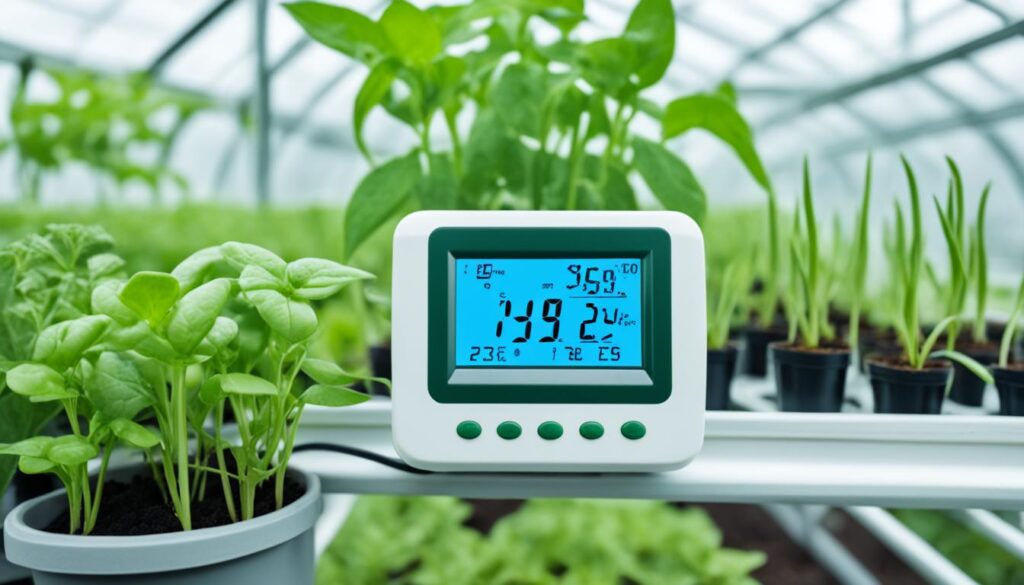
“Consistent temperature monitoring is the key to unlocking the full potential of your greenhouse gardening.” – Gardening Guru, Jane Doe
Floating Row Covers for Plant Protection
Row covers are a big deal for greenhouse gardening. They’re lightweight and let air and light through. This gives your plants an extra shield against cold snaps and pests. Adding row covers to your greenhouse setup helps your plants grow longer and stay safe.
Row covers are great for protecting against frost. In spring and fall, they keep seedlings and crops warm. Even in cold winters, the right row covers keep plants healthy and growing.
Row covers do more than just fight frost. They also keep insects, birds, and pests away from your plants. This means less damage and disease, leading to a bigger harvest.
If you want to improve your greenhouse gardening, think about using row covers. They offer many benefits, like protecting against frost and pests. These tools can make your plants last longer and grow better all season.
“Floating row covers are a must-have for any greenhouse gardener who wants to push the boundaries of their growing season.”
Transitioning to Outdoor Summer Growing
As the growing season moves forward, gardeners should think about moving some plants from the greenhouse to the outdoors. This shift makes the greenhouse more efficient. It also opens up space for more summer harvest crops.
When moving plants outside, it’s important to acclimate them gradually. This means starting with a little outdoor time and slowly adding more. This helps the plants get used to the sun and changing temperatures without shock.
Moving plants outside in the summer can boost their growth and yields. This means a bigger summer harvest for you. Using both the greenhouse and outdoor space can make your garden more efficient.
“Transitioning plants outside is like introducing a friend to a new environment – it takes time, patience, and care to ensure a smooth adjustment.”
The aim is to balance the greenhouse and the garden. This way, you make the most of your space all summer.
| Benefits of Transitioning Plants Outdoors | Considerations for Outdoor Acclimation |
|---|---|
|
|
Extending the Life of Annual Herbs
Greenhouses are great for making annual herbs like basil and cilantro last longer. These herbs are hard to grow all year in cold places. With a greenhouse environment that controls temperature, gardeners can have fresh herbs all year.
In a greenhouse, these delicate annual herbs do well. Gardeners can pick their favorite herbs from fall to winter. This way, they can enjoy fresh, tasty herbs all season long.
Using Greenhouses for Herb Growth
Greenhouses are perfect for growing herbs all year. They let gardeners keep their favorite herbs going even when it’s not the right time outside. Inside, plants are safe from bad weather. They get the right amount of light, temperature, and humidity to grow well.
| Herb | Outdoor Growing Season | Greenhouse Growing Season |
|---|---|---|
| Basil | Summer | Year-round |
| Cilantro | Spring to Fall | Year-round |
| Parsley | Spring to Fall | Year-round |
Using a greenhouse lets gardeners keep their annual herbs going all year. They can have a lot of herbs, no matter the weather outside.
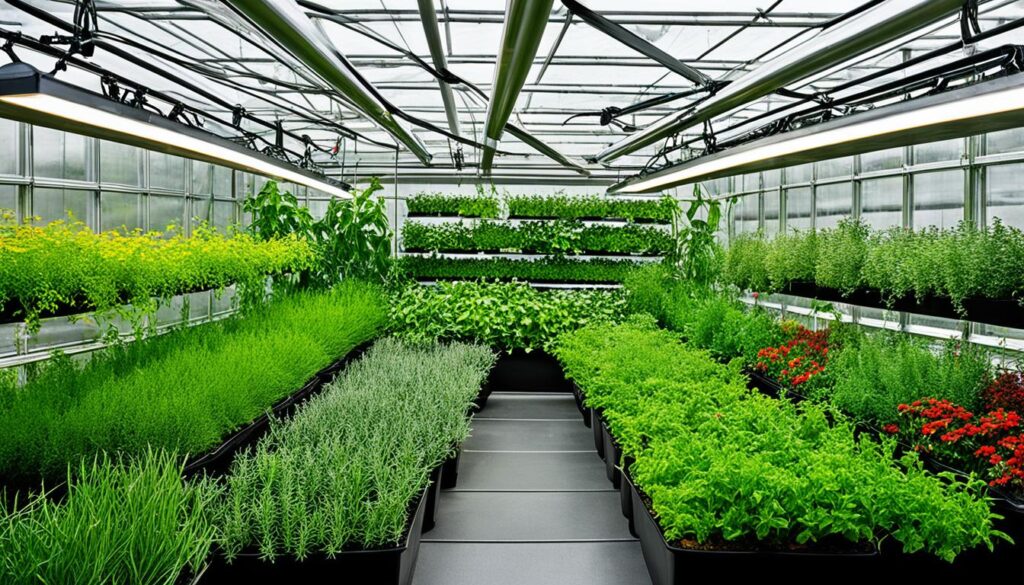
Greenhouse Gardening: Crop Choices
When planning your greenhouse garden, think about the crops that do well in the controlled space. Choose cold-hardy veggies like carrots, beets, and bunching onions for early planting. They handle cooler greenhouse temperatures well.
Later in the season, grow a variety of crops such as tomatoes, peppers, and cucumbers. For the best results, prepare the beds well. Till the soil 8-12 inches deep, add soil amendments, and cover rows with row covers to fight weeds before planting.
Preparing Greenhouse Beds for Planting
Choosing the right crops and preparing the space well can boost your greenhouse garden’s success. Here are steps to prepare your beds:
- Till the soil 8-12 inches deep for better root growth and air flow.
- Add organic stuff like compost or manure to make the soil richer and more fertile.
- Use row covers or mulch to keep weeds down and soil moist.
- Check the soil’s pH and adjust it if needed for your crops.
| Crop | Ideal Temperature Range | Ideal Soil pH |
|---|---|---|
| Tomatoes | 70-85°F | 6.0-6.8 |
| Peppers | 65-85°F | 6.0-6.8 |
| Leafy Greens | 55-75°F | 6.0-7.0 |
Plan your greenhouse crops and prepare your beds well. This way, you can have a thriving garden that grows more food for longer.
“Greenhouse gardening lets me grow more crops and extend my growing season. The key is to pick the right crops and prepare the beds right.”
Greenhouse Gardening Techniques
Greenhouse gardening needs special techniques for the best plant growth. Start with preparing your beds well. This means tilling the soil, adding nutrients, and using row covers to keep weeds away. It’s also key to think about ventilation, temperature, and moving plants between the greenhouse and outside.
To make the most of your greenhouse, use special planting methods. Start seeds indoors, move seedlings to the greenhouse, and manage temperature and humidity. Preparing your beds and optimizing conditions lets you grow more, longer, and enjoy fresh produce all year.
Preparing Greenhouse Beds for Planting
Before planting, make sure your beds are ready. Till the soil, add compost or manure, and use row covers for weeds. This makes a healthy, weed-free place for your plants to grow.
- Till the soil to a depth of 6-8 inches, breaking up any compacted areas.
- Mix in 2-4 inches of compost or other organic amendments to improve soil structure and fertility.
- Use floating row covers to block light and prevent weed growth between plantings.
Optimizing Greenhouse Conditions
Managing temperature, humidity, and ventilation is also crucial. This might mean using climate control systems, checking conditions, and adjusting as needed.
- Install a reliable thermometer and hygrometer to track temperature and humidity levels.
- Ensure adequate ventilation to prevent stagnant air and maintain proper air circulation.
- Utilize supplemental heating or cooling systems to maintain the ideal temperature range for your crops.
Using these greenhouse gardening tips, you can make the most of a protected space. This leads to a longer season, more produce, and fresh, quality food. With some knowledge and care, your greenhouse can be a thriving place for your plants.
“Greenhouse gardening allows me to grow a wider variety of crops and extend my growing season by several months. The extra control over environmental factors has been a game-changer for my home garden.”
– Sarah, Experienced Greenhouse Gardener
Conclusion
Greenhouse gardening opens up new chances for gardeners to grow more and longer. It lets you control the environment, making it perfect for many plants. You can grow everything from hardy veggies to delicate herbs and flowers.
Choosing between an unheated or heated greenhouse, or even a cheaper hoop house, changes everything. You can control the temperature, humidity, and light. This means you can grow food into late fall and early winter.
By watching the greenhouse conditions and using things like row covers, you can make a garden that grows all year. With some effort and the right methods, greenhouse gardening can change the game for all gardeners. It opens up new possibilities in your backyard.
Greenhouse gardening is full of potential. It lets you grow more, try new plants, and have a garden all year. If you’re starting or want to improve your gardening, this article has tips to help. It can make your greenhouse gardening successful and rewarding.
FAQ
What are the benefits of using a greenhouse?
Greenhouses let gardeners extend their growing season by up to 60%. They control temperature, humidity, and light for the best plant growth. This means you can start seeds early and keep harvesting into fall and winter. Plants stay healthy and productive by avoiding pests, harsh weather, and nutrient loss.
What’s the difference between an unheated and a heated greenhouse?
Choosing between an unheated or heated greenhouse depends on your climate and needs. Unheated greenhouses use the sun’s heat and are cheaper. They work well in mild climates, extending the growing season. Heated greenhouses let you grow crops all year but cost more to run.
How can at-home hoop houses extend the growing season?
At-home hoop houses, or high tunnels, are a budget-friendly way to extend the growing season. These structures use frames covered in plastic. They can add up to 5 months to your growing season, letting you start and end your crops earlier.
How can greenhouses help extend the late fall and early winter harvests?
Greenhouses let you harvest into late fall and early winter. By moving hardy vegetables like carrots and kale inside, you can enjoy fresh produce longer. The greenhouse’s warm and humid environment supports these plants, even when it’s cold outside.
How can greenhouses and protection tents enable year-round gardening?
Greenhouses and protection tents let gardeners grow crops all year. They protect plants from bad weather and pests, making it possible to garden in cold months. Protection tents are smaller and cheaper, perfect for gardeners with limited space.
Why is it important to monitor greenhouse temperature?
Keeping the right temperature in a greenhouse is key for healthy plants. Temperature changes can harm plants, causing growth problems or even death. Modern tech helps you monitor your greenhouse’s temperature and humidity easily.
How can floating row covers provide additional plant protection?
Floating row covers add extra protection to your plants. They keep out frost in spring and fall, protecting seedlings and crops. Heavy covers can even shield plants from freezing. They also block pests, keeping your crops safe.
When should plants be transitioned from the greenhouse to the outdoor garden?
Moving plants from the greenhouse to outside is important as the season goes on. It makes the greenhouse more efficient and frees up space. Move plants outside slowly, giving them time to get used to the sun and temperature changes.
How can greenhouses help extend the life of annual herbs?
Greenhouses are great for growing annual herbs like basil and cilantro year-round. They provide a warm, humid space for these delicate plants. This way, you can enjoy fresh herbs into the fall and winter.
What should gardeners consider when planning their greenhouse crops?
Think about which crops do well in a greenhouse when planning your garden. Early season, cold-hardy veggies like carrots grow well in greenhouses. Later, you can grow a variety of crops. Prepare your greenhouse beds well, till the soil, add amendments, and use row covers to help plants grow.
Source Links
- https://mrcrazykicks.com/how-much-can-a-greenhouse-extend-the-growing-season/ – How Much Can a Greenhouse Extend the Growing Season?
- https://sunshinegreenhouse.com/blogs/sunshine-greenhouse-kit-blog/using-a-greenhouse-to-extend-the-growing-season – Using a Greenhouse to extend the growing season
- https://www.new-terra-natural-food.com/growing-plants-in-a-greenhouse.html – Growing plants in a greenhouse to extend your growing season
Companion Planting Guide: Boost Your Garden’s Health
Imagine a garden full of life where each plant helps the others grow. What if you could make a garden where plants work together to fight pests, make the soil better, and use space well? The answer is companion planting. By placing plants together wisely, you can make your garden better and get more from your work.
Companion planting is an old gardening trick that uses the natural benefits of different plants together. By having a garden with many kinds of plants, you make a system that helps everyone. This way, you get rid of pests, make the soil better, and make your garden more productive.
Key Takeaways
- Discover the secrets of companion planting for a thriving, sustainable garden
- Learn how to leverage natural plant relationships for improved pest control and productivity
- Explore the science behind companion planting and its benefits for your garden
- Maximize your growing space through strategic planting techniques
- Enhance soil health and fertility with companion planting practices
Are you ready to make your garden better and have a lush, full garden? Start with companion planting and turn your backyard into a green, self-sustaining place.
What is Companion Planting?
Companion planting means growing different plants together to help each other out. This method creates a diverse garden that benefits from natural connections between plants, insects, and soil. It helps your garden stay healthy and productive by fighting pests, improving soil, and reducing weeds.
Definition and Benefits of Companion Planting
Companion planting is all about plants helping each other out. Some plants protect against pests, while others make the soil better or keep weeds down. This method offers many advantages, like natural pest control, boosting soil fertility, and weed suppression. It leads to increased yields and makes gardening more sustainable and successful.
The Science Behind Companion Planting
Studies have shown how companion planting works, revealing the complex relationships between plants and insects. Some plants can keep pests away with their chemical defenses or by attracting beneficial insects. For instance, nasturtiums near fruit trees can keep moths away, and radishes with pumpkins can protect against squash bugs. This science highlights the intricate connections in a diverse garden.
“By growing communities of plants that are known to support each other, you can save a lot of time and potential heartache.”
Saving Space with Companion Planting
If you have a small garden, companion planting can change the game. By interplanting crops and using container gardening, you can use every inch of space. You’ll grow many plants and enjoy how they work well together.
Interplanting Techniques for Small Gardens
Succession planting is key for saving space. Plant quick-growing crops like lettuce or radishes with slower ones like tomatoes. When you pick the early crops, the others have room to grow. This saves space and helps with weed management and soil health.
Maximizing Space with Container Gardening
Container gardening is great for small spaces. Use big planters or raised beds for a “salad garden” or “pizza garden”. This lets you grow many plants in a small area. You’ll enjoy the benefits of companion planting too.
Whether you have a tiny balcony or a small yard, companion planting can make your garden better. It helps you grow a space-saving garden that gives you lots of food.
Improving Soil Health through Companion Planting
Improving your garden’s soil health is key to a thriving garden. Companion planting is a natural way to do this. By pairing plants together, you use their unique roots and nutrient-cycling to make a better garden ecosystem.
Utilizing Different Root Structures
Companion planting uses the different root systems of plants to improve soil health. Mixing deep-rooted and shallow-rooted plants makes the most of soil resources. Deep-rooted plants like tomatoes and carrots get nutrients from deep in the soil. Shallow-rooted plants like lettuce grow well in the top layers.
This mix helps aerate the soil and keeps nutrients from running out. It’s a smart way to make your garden more resilient.
Incorporating Legumes for Nitrogen Fixation
Legumes like peas, beans, and clover are great for soil health. They can take nitrogen from the air and add it to the soil for other plants. This means you use fewer synthetic fertilizers and keep your garden healthy.
You can eat the legumes or use them as cover crops. Their leaves and roots add nitrogen to the soil. This is a smart way to make your garden better for the environment and for you.
Using different plants together can really help your garden’s soil. Whether you focus on roots or nitrogen, these methods make for a healthy, easy garden. It’s good for the planet and good for you.
Mutual Support through Companion Planting
The three sisters method is a classic example of how plants help each other grow. It involves planting corn, beans, and squash together. This technique has been used by indigenous communities in Mesoamerica for hundreds of years. It shows how plants can work together to improve their growth.
In this system, the corn acts as a support for the beans to climb on. The beans then fix nitrogen in the soil, which helps the corn and squash grow better. The squash uses its big leaves to keep weeds away and protect the corn from pests like raccoons.
“The three sisters model is a testament to the wisdom of traditional planting techniques and the power of mutual support in the garden.”
The three sisters method is part of the milpa farming way. It combines corn, beans, and squash with other crops and animals. This approach creates a diverse and strong farming system. By using physical support and nutrient cycling, gardeners can make the most of their land and grow a healthy, self-supporting garden.
Companion Planting for Insect Management
Gardeners looking to control pests naturally can use companion planting. This method attracts beneficial insects and pollinators. It also uses trap cropping and repellent plants to keep away insect pests.
Attracting Beneficial Insects and Pollinators
Adding nectar-rich plants to your garden draws in helpful insects. Syrphid flies, which eat aphids, are a great example. These bugs lay their eggs near aphids, controlling pests naturally.
- Include flowers like cosmos, zinnias, and sunflowers to attract syrphid flies and pollinators.
- Grow brassicas such as arugula, mustard, and napa cabbage for aphid predators.
- Choose cucurbit plants like blue hubbard squash to trap cucumber beetles.
Trap Cropping and Repellent Plants
Companion planting can also trap pests away from your main crops with trap cropping. “Spicier” brassica varieties can draw flea beetles away from your main plants.
Plants with strong smells and defenses, like marigolds, nasturtiums, and garlic, can repel insects from your garden.
“Companion planting is a powerful tool for managing garden pests organically and promoting a thriving, balanced ecosystem in your backyard oasis.”
Companion Planting with Herbs and Flowers
Herbs and flowers are key in companion planting. Many herbs, like basil, dill, and sage, have strong smells that keep insects away. Flowers draw in helpful insects with their nectar and pollen.
Adding herbs and flowers to your garden helps fight pests and attract pollinators. This makes your garden healthier and more balanced. Companion planting with herbs and flowers offers many benefits, including:
- Natural Pest Control: Some herbs’ smells confuse garden pests, reducing the need for chemicals.
- Pollinator Attraction: Flowers draw bees and butterflies, which are key for plant health and growth.
- Beneficial Insect Habitats: Flowers and herbs are homes for insects that eat garden pests.
When planning your companion planting with herbs and flowers, think about what your vegetables need and the traits of different plants. A diverse garden helps control pests and pollination, leading to a better harvest.
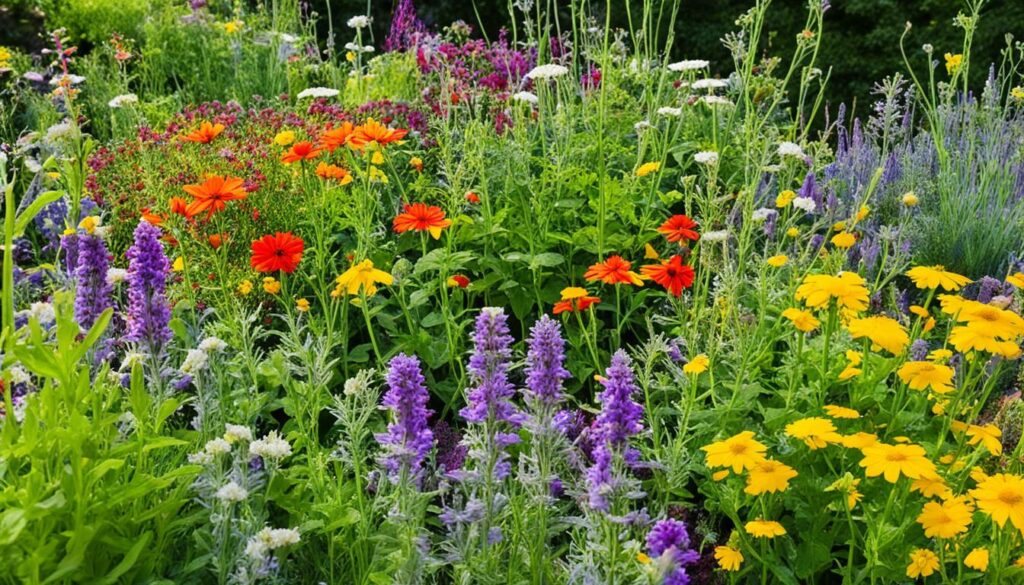
“Companion planting with herbs and flowers is a simple yet powerful way to create a more resilient and productive vegetable garden. By harnessing the natural pest-fighting and pollinator-attracting properties of these plants, you can cultivate a thriving, balanced ecosystem that benefits both you and the environment.”
Choosing the Right Herbs and Flowers
When picking herbs and flowers for your companion planting, think about what your vegetables need and the plants’ unique traits. Some top picks for companion planting with herbs are:
- Basil: Keeps aphids away and protects tomatoes.
- Dill: Draws in ladybugs and lacewings that eat pests.
- Marigolds: Deters nematodes and other pests in the soil.
For companion planting with flowers, plant a mix of flowers to attract many pollinators and beneficial insects, such as:
- Sunflowers: Offer nectar and pollen for bees and other pollinators.
- Nasturtiums: Repel aphids and other pests from vegetables.
- Cosmos: Attract ladybugs and lacewings.
| Herb/Flower | Pest Repelling | Pollinator Attraction | Beneficial Insect Habitats |
|---|---|---|---|
| Basil | ✓ | ||
| Dill | ✓ | ||
| Marigolds | ✓ | ||
| Sunflowers | ✓ | ||
| Nasturtiums | ✓ | ||
| Cosmos | ✓ |
Proven Companion Planting Combinations
Companion planting is a great way to make your garden healthier and more productive. By pairing certain plants together, you can fight off pests and make the soil better. Let’s look at some top combinations to try in your garden.
Brassicas: Cabbage, Broccoli, and Kale
Brassicas like cabbage, broccoli, and kale do well together. The “spicier” ones, like arugula, mustard, and napa cabbage, can lure pests away from the main crops. Sage, thyme, and nasturtium also help keep pests like diamondback moth and cabbage worms off.
Tomatoes and Basil
Basil and tomatoes are a great pair. Basil keeps thrips and moths away from tomatoes. It also brings in bees, which helps pollinate the tomatoes and makes them taste better.
Squash and Pumpkins
Squash and pumpkins benefit a lot from companion planting. Blue hubbard squash, for example, draws in pests away from other squash. Nasturtiums near squash and pumpkins also keep pests down. Plus, having many flowers helps pollinators, which are key for these plants.
“Companion planting is a time-honored technique that can help create a more resilient and productive garden.”
Companion Planting Chart
Companion planting isn’t a hard science, but a chart can help gardeners. These charts list veggies, herbs, and flowers with their best friends and foes. By using a chart and noting what works for you, you can find the best plant pairs for your garden.
A good chart shows how different plants work well together. These pairs can boost soil health, draw in good bugs, and keep pests away. Knowing about these plant friendships can make your garden better and stronger.
| Plant | Beneficial Companions | Antagonistic Companions |
|---|---|---|
| Tomatoes | Basil, Marigolds, Nasturtiums | Potatoes, Fennel, Corn |
| Carrots | Radishes, Chives, Rosemary | Dill, Parsnips |
| Cucumbers | Marigolds, Nasturtiums, Radishes | Potatoes, Aromatic Herbs |
| Lettuce | Carrots, Radishes, Beets | Parsley, Celery |
This chart is just a starting point. The best plant pairs can change with your local weather, soil, and more. Try different combos and keep track of what works best for your garden.
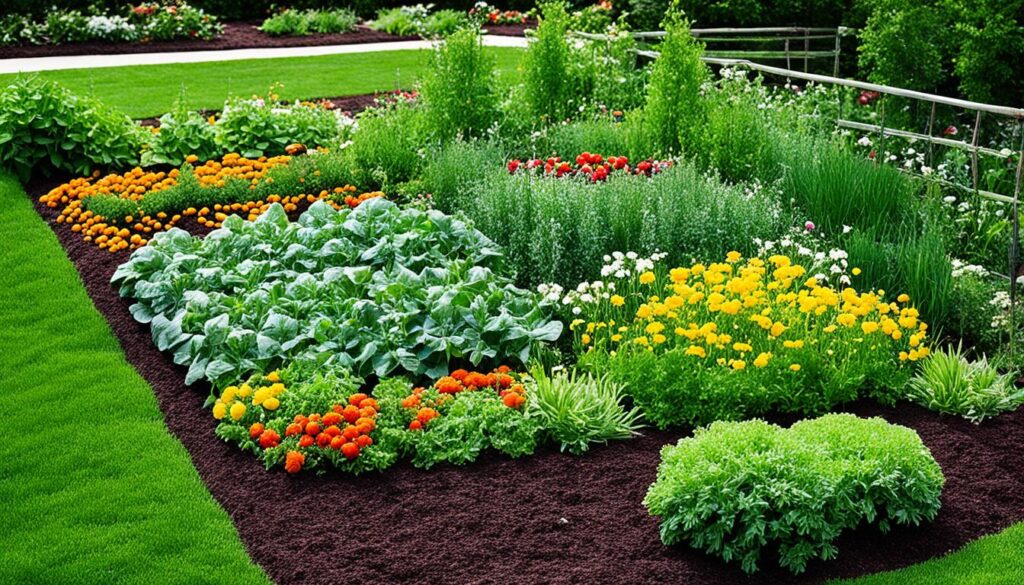
“Companion planting is like a dance between plants, where each one plays a unique role in supporting the others.”
Getting Started with Companion Planting
Starting your companion planting journey is a fun step towards a better garden. First, plan your garden layout well. Think about how long each plant takes to grow, what nutrients it needs, and its size when choosing which plants to grow together. Interplanting, where you plant different crops close to each other, helps use space well and boosts garden productivity, especially in small gardens.
Container gardening is a great way to try out companion planting too. You can make “theme” gardens, like a pizza or salad garden, in one big container. This lets you enjoy the benefits of companion planting even if you have little outdoor space.
Planning Your Garden Layout
Here are some tips for planning your garden layout:
- Put plants with similar growth rates and habits together to avoid competition for resources.
- Pair tall, sun-loving plants with shorter, shade-tolerant ones to make the most of vertical space.
- Think about what each crop needs in terms of nutrients and arrange them to help each other out.
Record-Keeping and Experimentation
Companion planting isn’t a hard science, and what works for one garden might not work for another. It’s key to keep detailed records of your experiments. Note which plant combinations worked and which didn’t. Over time, this will help you adjust your companion planting to fit your garden’s unique conditions.
Don’t hesitate to try new plant pairings and learn from them – the more you experiment, the better you’ll get at using companion planting. With patience and a readiness to adapt, you’ll find the best combinations to make your garden healthier and more productive.
Conclusion
Companion planting is a key to a successful, sustainable garden. By pairing plants that help each other, you can use space better, improve soil, control pests, and boost your harvest. It works well in small gardens or big plots, creating a balanced ecosystem.
Start your gardening adventure by trying new plant combinations. Find the best ones for your garden’s needs. Companion planting not only increases your harvest but also helps the planet.
Discover the secrets of companion planting to make your garden better. With creativity and respect for nature, you can grow a garden that feeds your plants and your soul. Begin your journey and watch your garden grow with the magic of companion planting.
FAQ
What is companion planting?
Companion planting means growing plants together for mutual benefits. It pairs plants that help each other out. This method reduces pests, improves soil, and increases garden yields.
What are the benefits of companion planting?
Companion planting offers many advantages. It controls pests naturally, enriches soil, and makes better use of space. It also boosts garden productivity by creating a balanced ecosystem.
How does companion planting work?
It works by attracting beneficial insects, keeping pests away, offering support, and improving soil nutrients. This complex system shows how plants and insects are connected.
How can companion planting help with space-saving in the garden?
It saves space by planting early and late crops together. You can also grow different plants in one container, like a “pizza garden” or “salad garden”.
How does companion planting improve soil health?
It boosts soil health by mixing plants with varied roots. This aeration and nutrient access help plants grow better. Legumes also add nitrogen to the soil naturally.
Can companion planting help with pest management?
Yes, it’s a natural way to fight garden pests. Some plants attract beneficial insects. Others act as trap crops or repellents, keeping pests away from your main plants.
What are some proven companion planting combinations?
Effective pairs include brassicas with other brassicas, tomatoes with basil, and squash with blue hubbard squash or nasturtiums.
How do I get started with companion planting?
Start by planning your garden well, thinking about plant growth and nutrient needs. Keep track of your results and adjust your strategy as needed for your garden.
Source Links
- https://www.almanac.com/companion-planting-guide-vegetables – Companion Planting Chart and Guide for Vegetable Gardens
- https://extension.wvu.edu/lawn-gardening-pests/gardening/garden-management/companion-planting – Extension | Companion Planting
- https://extension.umn.edu/planting-and-growing-guides/companion-planting-home-gardens – Companion planting in home gardens
Beginner’s Guide to Companion Planting
Are you a budding gardener looking to learn about companion planting? This guide is for you! It covers the basics of this old gardening trick. You’ll learn how to use plant partnerships to make your garden thrive. It’s perfect for beginners wanting a lush, eco-friendly garden. Ready to discover the secrets of your garden’s potential?
Key Takeaways
- Companion planting is an ancient gardening technique that pairs plants for mutual benefit
- It can help deter pests, attract pollinators, and improve soil health
- Successful companion planting requires understanding compatible plant relationships
- Beginners can start with simple pairings like tomatoes and basil or cucumbers and sunflowers
- Embracing the interconnectedness of your garden is key to effective companion planting
What is Companion Planting?
Companion planting is a gardening trick that pairs different plants together for mutual benefits. It’s a smart move for beginner gardening tips and companion planting for newbies. This method boosts the health and yield of your garden.
Understanding the Practice
Companion planting means making your garden a diverse place where each plant helps the others. By starting companion planting with simple plant pairings, you use nature’s connections. This helps fight pests, enrich soil, and grow plants better.
Benefits of Companion Planting
- Attracts beneficial insects like pollinators and pest predators
- Provides natural pest control by repelling or confusing harmful insects
- Improves soil health by adding nutrients or preventing nutrient depletion
- Offers physical support or shade for more delicate plants
- Maximizes limited garden space by utilizing vertical and horizontal growth
- Enhances the overall biodiversity and resilience of your garden ecosystem
Learning the basics of companion planting can make your garden better. It becomes a lush, easy-care spot that looks great and produces well.
“Companion planting is all about working with nature, not against it. When you create the right plant partnerships, your garden will thrive with minimal effort.”
Planning a Companion Planting Garden
Before starting your companion planting journey, learn about crop rotation. Don’t plant the same crops in one spot every year. This can cause pest and disease problems and make the soil nutrient-poor. Start with a few well-known plant pairings when you begin.
For a successful companion planting garden, put plants close together but not too close. Check the seed packet and plant care guides for spacing advice. This helps your simple plant pairings grow well.
If you’re new to companion planting for newbies, start small. Try a few beginner gardening tips and see what works. With some trial and error, you’ll soon have a garden that’s full of life and pests.
“Companion planting is like a dance, where each plant has a role to play in creating a harmonious and productive garden.”
Successful companion planting means knowing what your plants need. By planning and experimenting, you can make a garden that’s beautiful and productive. Your chosen plant partners will help it thrive.
Companion Planting with Flowers
Companion planting with flowers is key to a successful vegetable garden. Flowers like nasturtiums, sunflowers, marigolds, and zinnias help fight pests and draw in helpful insects. They make your garden look great and work hard to keep pests away.
Attracting Pollinators
Bees and butterflies are vital to your garden’s success. They spread pollen, helping your plants grow and produce more food. Flowers that attract these pollinators include zinnias, sweet alyssum, daisies, sunflowers, and cosmos.
Natural Pest Repellents
Some flowers keep pests away from your veggies. Petunias, for example, keep squash bugs and tomato hornworms away. They’re perfect for beans, tomatoes, and corn.
Marigolds keep cabbage worms off cabbage, mustard greens, kale, broccoli, and Brussels sprouts. Ornamental alliums, like onions and chives, also keep deer, rabbits, and other pests away.
By using companion planting with flowers, your garden becomes a balanced ecosystem. It looks good and naturally controls pests, helping your veggies grow strong and healthy.
The Science Behind Companion Planting
The study of companion planting is really interesting. It looks at how different plants help or protect each other. By pairing certain plants together, gardeners can boost growth, keep pests away, and create a healthy garden.
Companion planting is complex, involving chemical signals, physical touches, and ecological links. Studies have highlighted how some plants and insects work together. This shows the benefits of placing plants in a smart way.
For instance, radishes near pumpkins can keep squash bugs away. Nasturtiums around fruit trees stop pests like codling moths. This is because nasturtiums release chemicals into the soil that help the trees fight off pests.
Brassica plants, like mustards and kale, also fight off pests with special chemicals. Some plants work well together because one hides the other from pests. Tomato and basil are a great example of this.

Companion planting shows how connected our gardens are. By knowing these plant relationships, gardeners can make their gardens healthy and productive. This approach cuts down on the need for chemicals and boosts plant health.
Examples of the Best Companion Plants
Some plant pairs are true stars in the garden. Tomatoes and basil, and cucumbers, sunflowers, and pole beans are great examples. They work well together and help each other grow.
Tomatoes and Basil
Basil and tomatoes are like the best friends in the garden. Basil keeps away thrips and stops moths from eating tomatoes. It also brings bees that help pollinate tomatoes, making them healthier and tastier.
This pairing shows how some plants help each other out. They create a garden that’s full of life and benefits everyone.
Cucumbers, Sunflowers, and Pole Beans
Cucumbers, sunflowers, and pole beans make a great team. Sunflowers help the beans grow up towards the sky. Cucumbers spread out on the ground, keeping it weed-free and protecting the soil.
This planting idea is similar to the “three sisters” method. Corn, beans, and squash work together, helping each other grow. It’s all about plants helping plants.
Choosing the right plant friends can make your garden better. It keeps pests away, helps with pollination, and makes plants healthier. These examples show how companion planting can make gardening easier and more rewarding.
Beginner’s Guide to Companion Planting
Companion planting is a way to put different plants together to help each other grow. It’s about making a garden where plants work together. This method is popular with gardeners and farmers who want to boost plant growth and keep pests away naturally.
If you’re new to companion planting, it’s easy to start. The main idea is to pick plants that help each other out. Some plants offer shade or support, while others keep pests away. Knowing how companion planting works lets you grow a garden that’s full of life and doesn’t need much work.
Here are some tips for starting your companion planting adventure:
- Look up plant combinations that work well together, like tomatoes and basil or cucumbers and sunflowers.
- Watch how plants interact in your garden and try new pairings.
- Make sure your plants need the same amount of sunlight and water.
- Rotate your crops every year to stop pests and diseases from spreading.
“Companion planting is a simple, effective way to create a thriving, low-maintenance garden that benefits both you and the environment.”
By using these companion planting basics, you can start a fun journey in gardening. It doesn’t matter if you’re new to gardening or have been doing it for years. Intro to companion planting can show you how to make the most of your garden space.
Crop Rotation and Companion Planting
Before you plan your garden, know why crop rotation is key. It means growing different crops in the same spot one after another. This keeps the soil healthy, controls weeds, and fights pests and diseases.
Using companion planting with crop rotation brings big benefits. By rotating crops and placing them wisely, you make a garden that’s easy to care for and fights off garden problems.
- Rotate crops every year to stop soil from losing nutrients and to keep pests and diseases away.
- Plant crops together that help each other out, like keeping pests away, improving soil, and sharing nutrients.
- Combine crop rotation and companion planting for a garden that’s healthy and productive overall.
| Crop Rotation | Companion Planting |
|---|---|
| Maintains soil fertility | Enhances pest and disease resistance |
| Suppresses weed growth | Improves nutrient cycling |
| Reduces pest and disease pressures | Increases biodiversity |
By integrating companion planting with crop rotation, you make a garden that’s strong against garden challenges. This way of gardening leads to a garden full of life and a good harvest.
Plant Families for Companion Planting
Companion planting is a great way for gardeners to improve their gardens. It’s all about knowing how different plants work well together. The nightshade and legume families are two examples that do well when planted together.
Nightshades
The nightshade family includes tomatoes, peppers, eggplants, and potatoes. These plants can do better with the right companions. For example, basil near tomatoes keeps pests away and makes the tomatoes taste better.
Marigolds or tagetes are great with peppers. They keep aphids and other pests away from nightshades.
Legumes
Legumes like beans and peas are known for fixing nitrogen in the soil. This means they can make the soil richer for other plants. When planted with other crops, they help those plants grow stronger.
Beans or peas with corn or brassicas like cabbage and broccoli work well together. The corn supports the legumes, and the brassicas use the nitrogen the legumes fix.
Knowing how different plant families work together can help you create a better garden. This approach makes your garden more productive and sustainable.
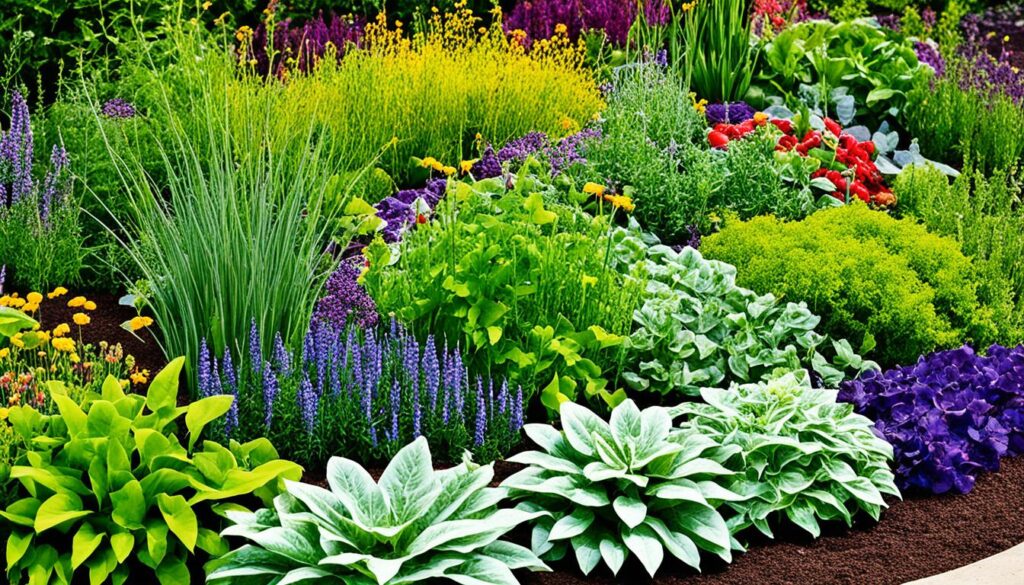
Herbs as Companion Plants
Growing herbs with your vegetables can bring many benefits. These plants help keep pests away, draw in good bugs, and make nearby crops taste better.
Basil and tomatoes work well together. Basil keeps thrips away from tomatoes and stops tomato hornworms from eating them. Its scent also hides the tomatoes from pests.
Dill is another great herb for your garden. It brings in ladybugs and wasps that eat garden pests. This means you use fewer harmful chemicals in your garden.
Mint and garlic are also good for your garden. Mint keeps rabbits and ants away, and garlic scares off many pests. It even fights off some diseases.
Adding these herbs to your garden makes it a healthy place for all your plants. Using herbs helps you avoid harmful chemicals. It makes your garden a better place for nature and you.
Bad Companion Plant Combinations
Companion planting can boost your garden’s productivity and health. But, not all plants get along well together. Some plants can harm each other, causing smaller plants, less food, and unhappy gardening.
Don’t mix fast-growing zucchini or winter squash with delicate lettuces. The squash will cover the lettuce, leaving you with less to eat. Tomatoes and corn also don’t work well together. They fight over water and nutrients, and the tomatoes need more sun than corn does.
| Incompatible Companion Plants | Reason for Incompatibility |
|---|---|
| Zucchini or Winter Squash and Lettuce | Zucchini/squash vines quickly outgrow and overshadow the lettuce |
| Tomatoes and Corn | Compete for nutrients, water, and corn casts too much shade on sun-loving tomatoes |
Knowing what your plants need is key to a great garden. By picking the right plants to be together, your garden will do well and give you lots of food.
“Companion planting is all about understanding the unique needs and growth habits of your plants. Avoid pairing plants that will compete for resources and end up stunting each other’s growth.”
Successful companion planting means finding the right balance in your garden. Learn which plants don’t mix well to make your garden better. This way, you’ll enjoy the perks of this gardening method.
Conclusion
Companion planting makes your garden a thriving, harmonious place. By pairing plants wisely, you can fight pests, improve soil, and grow more food. Using herbs to keep pests away and flowers to attract good bugs is a smart move.
Exploring the science behind plant partnerships reveals a complex web of relationships. This knowledge lets you choose the best plant combinations for your garden. It’s great for both new and seasoned gardeners looking to improve their gardens.
Companion planting is a green way to grow food and plants. It changes how you garden, making your space more diverse and full of life. By focusing on this method, you’re on your way to a lush, productive garden.
FAQ
What is companion planting?
Companion planting means growing different plants together for mutual benefits. It helps keep pests away, attracts good insects, and improves soil health. Plants also provide shade, support each other, and make the soil richer.
What are the key benefits of companion planting?
Key benefits include drawing in bees and insects that eat pests. Tall plants shade smaller ones and help them grow. Also, some plants make the soil better by fixing nitrogen.
How do I get started with companion planting?
Start by following crop rotation rules. Don’t plant the same crop in one spot year after year to avoid pests and nutrient issues. Then, pick plant combinations that work well together in your garden.
What are some simple companion plant pairings to try?
Try pairing basil with tomatoes, cucumbers with sunflowers, or the “three sisters” of corn, pole beans, and squash.
How does companion planting work to deter pests and attract beneficial insects?
Some plants, like marigolds and nasturtiums, keep pests away with their strong smells or by adding compounds to the soil. Others, such as zinnias and cosmos, draw in helpful insects that fight pests.
Are there any plant combinations I should avoid in companion planting?
Yes, don’t plant crops that fight over resources like sunlight, water, or nutrients. For example, zucchini and lettuce don’t mix well, and tomatoes and corn use up too many resources together.
Source Links
Seasonal Guide to Companion Planting
Unlock the secrets to a thriving garden all year with our guide to companion planting. But what is companion planting, and how does it help your garden? Learn about strategic plant pairings to make your garden better.
Key Takeaways
- Companion planting is the practice of growing different plants together for mutual benefit.
- Discover the advantages of companion planting, from pest control to increased yields.
- Explore seasonal companion plant pairings for your garden, from spring to winter.
- Learn how to plan a companion planting garden for maximum effectiveness.
- Attract beneficial insects and deter pests with the right companion plants.
Understanding Companion Planting
Companion planting is a way to grow plants together to help each other. It’s an old method that says plants can help each other out. By doing this, each plant gets something good from the others in the companion planting basics.
What is Companion Planting?
It’s about making a garden where different plants live together well. By choosing the right plants to grow side by side, gardeners can make their gardens healthier and more productive. This means picking plants that attract good bugs, keep pests away, or make the soil better.
Benefits of Companion Planting
The benefits of companion planting are many and can change how you garden. Some main advantages are:
- Less pest damage from natural pest control
- Better soil nutrition and fertility
- More pollination and higher yields
- Smart use of garden space
- Beautiful and varied plantings
Learning about companion planting helps you make a garden that works well with nature.
“Companion planting is a time-honored gardening technique that allows plants to work together, resulting in a more productive and beautiful garden.”
Planning a Companion Planting Garden
When planning a garden, picking the right plants is key. Some plants help each other grow, while others can harm each other. It’s important to choose plants that work well together.
Choosing Compatible Plants
Look for plants that grow well together. Tomatoes and basil are great together because basil keeps pests away from tomatoes. Marigolds also help by fighting off pests in the soil.
Considering Plant Growth Habits
Think about how tall and big plants will get. Taller plants can shade smaller ones that need sunlight. Vines can climb up trellises, saving space in your garden.
| Plant | Companion Plants | Incompatible Plants |
|---|---|---|
| Tomatoes | Basil, Marigolds, Chives | Potatoes, Fennel, Dill |
| Carrots | Radishes, Chives, Rosemary | Dill, Parsnips |
| Lettuce | Carrots, Radishes, Cucumbers | Broccoli, Cauliflower |
Planning carefully will help you create a garden that works well together. This way, you get the most out of companion planting.
Spring Companion Planting
As the weather gets warmer and the earth awakens, it’s a great time to dive into spring companion planting. By thoughtfully pairing vegetables, herbs, and flowers, you can make a garden that flourishes all spring long.
Spring Vegetable Companions
When setting up your spring vegetable garden, think about which plants work well together. Asparagus and basil or marigolds can keep pests away and draw in good bugs. Broccoli and cabbage do well with nasturtiums, which lure aphids away. Carrots are happy with rosemary or sage, which keep carrot flies at bay.
Spring Flower Companions
Adding spring flowers to your garden can really boost the ecosystem. Flowers like borage, dill, and poached egg plants attract bees and butterflies, which are key for your garden’s success. These flowers also bring in beneficial bugs, like ladybugs and lacewings, that eat garden pests.
| Spring Vegetable | Companion Plants | Benefits |
|---|---|---|
| Asparagus | Basil, Marigolds | Pest deterrence, Beneficial insect attraction |
| Broccoli, Cabbage | Nasturtiums | Trap cropping, Pest deterrence |
| Carrots | Rosemary, Sage | Pest deterrence |
Choosing the right spring companion plants helps your garden grow well and look great. Enjoy the season’s abundance with a well-thought-out spring planting plan.
Summer Companion Planting
As summer comes, companion planting opens up new ways to make your garden better. It brings special pairings and strategies for the summer season. These can boost your garden’s productivity and beauty.
Summer is a great time to use plants that give shade and support to others. For example, tall corn plants can shade lettuce from the hot sun. Vines like cucumbers can grow up pole beans, helping each other out and saving space.
Summer is perfect for adding flowers that keep pests away and attract pollinators. Flowers like sunflowers, zinnias, and cosmos brighten up your garden. They also keep pests away and draw in helpful insects for your crops.
| Companion Plant | Benefit |
|---|---|
| Corn | Provides shade for lettuce and other leafy greens |
| Cucumbers | Climbs and intertwines with pole beans, providing mutual support |
| Sunflowers | Deter pests and attract pollinators |
| Zinnias | Deter pests and add vibrant color to the garden |
| Cosmos | Attract beneficial insects and pollinators |
By carefully choosing your summer plants and using companion planting, you can make a garden that’s full of life. It will be good for your plants and the environment too.
Fall Companion Planting
As summer ends and autumn arrives, the garden changes. It starts to focus on plants that do well in cooler weather and less sunlight. By choosing the right plants together, gardeners can make their gardens last longer, keep pests away, and make it look beautiful.
Fall Vegetable Companions
With the days getting shorter, vegetables like kale, brussels sprouts, and root crops shine. These plants do great in the cool. Adding garlic or sage near them keeps pests away. Radishes help by aerating the soil and drawing pests away from the main plants.
Fall Flower Companions
Flowers like chrysanthemums, asters, and marigolds are perfect for fall. They add color to the garden and attract helpful insects. These insects keep pests away. Adding these flowers to your garden keeps it healthy and full of life even in the cooler months.
| Fall Vegetable Companions | Fall Flower Companions |
|---|---|
|
|
Fall companion planting lets gardeners have a garden that’s full of life and looks great. It’s easy to take care of and keeps going even after summer ends.
Winter Companion Planting
When winter comes, companion planting is still key for your garden. By picking the right plants together, you can make a winter garden that thrives, even in tough conditions.
Winter Vegetable Companions
Winter companion planting helps protect delicate crops. Pair cold-hardy greens like spinach and kale with taller plants that block wind and frost. Onions and herbs like rosemary and thyme are great for winter, adding strength to your garden.
- Spinach: Pair with taller, bushy plants for wind and frost protection
- Onions: Provide a sturdy base for winter vegetable companions
- Rosemary and thyme: Hardy herbs that can withstand winter conditions
Arranging your winter plants wisely makes your garden stronger and more productive, even when it’s cold. Use companion planting to overcome winter gardening challenges and enjoy a rich harvest.
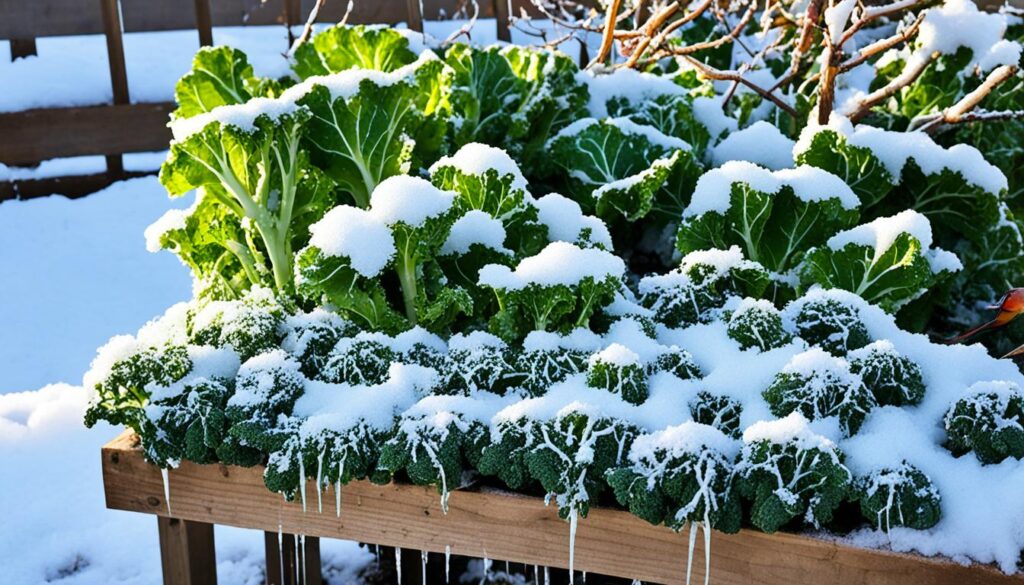
“Companion planting is a fantastic way to maximize the potential of your winter garden, even in the face of challenging conditions.”
Popular Companion Planting Combinations
Companion planting is a gardening method that pairs plants together for mutual benefits. Tomatoes and basil, and the “Three Sisters” of corn, beans, and squash, are top choices. These combinations help each plant grow better.
Tomato and Basil
Tomatoes and basil are a classic pair in gardening. Basil keeps pests away from tomatoes and makes them taste better. This duo is perfect for gardeners.
The Three Sisters: Corn, Beans, and Squash
The Three Sisters method has been used by Native American tribes for years. Corn, beans, and squash help each other out in many ways. Corn stalks support beans, and squash leaves keep weeds down and soil moist.
| Crop | Benefit |
|---|---|
| Corn | Provides structure for beans to climb |
| Beans | Fix nitrogen in the soil, improving corn and squash growth |
| Squash | Shades the soil, preventing weed growth and retaining moisture |
These combinations show how planting certain plants together can make a garden better. It’s all about creating a balanced garden ecosystem.
“Companion planting is a gardening technique that pairs certain plants together to create mutually beneficial relationships.”
Seasonal Companion Planting Guide
Crafting a thriving garden is all about understanding how plants work together. Seasonal companion planting lets you use these natural partnerships to boost growth, control pests, and increase productivity all year.
Whether you’re starting with spring veggies, summer flowers, or fall harvests, this guide will show you the best plant friends for each season. By choosing plants that grow well together, you can make a garden that fights pests and diseases. It will also draw in helpful insects.
Spring Companion Planting
In spring, pair leafy greens with radishes or carrots. These strong-smelling veggies keep pests away from your spring greens. Also, marigolds near tomato plants can fend off harmful insects and nematodes.
Summer Companion Planting
With the heat up, team peppers and eggplants with basil or borage. These friends not only taste better together but also bring in helpful pollinators to your garden.
Fall Companion Planting
When it gets cooler in fall, pair brassicas like kale and broccoli with aromatic herbs such as rosemary and thyme. These teams keep pests away and boost your fall crops’ health.
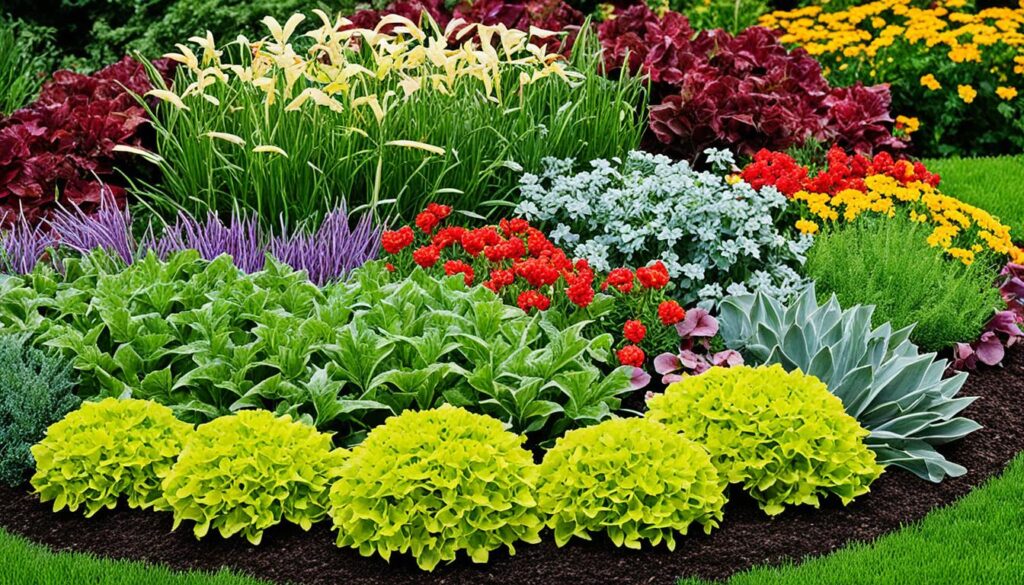
Using this seasonal companion planting guide, you can make a garden that thrives all year. Smart plant pairings boost growth, attract good bugs, and keep pests away.
Attracting Beneficial Insects
Companion planting is a great way to draw beneficial insects like pollinators and pest predators to your garden. By adding flowers full of nectar, you can attract bees, butterflies, and hoverflies. These insects will help pollinate your plants and eat pests.
Flowering Plants for Pollinators
Zinnias, cosmos, and sunflowers are great flowers that are full of nectar. They make your garden more diverse and healthy. These plants bring in many beneficial insects, including:
- Bees – essential for pollinating many fruits and vegetables
- Butterflies – add a touch of beauty while also pollinating flowers
- Hoverflies – feed on aphids and other garden pests
Adding flowering plants for pollinators to your garden makes it healthier and less dependent on chemicals. It also means you’ll need fewer pesticides. By attracting beneficial insects, your plants will do better and you’ll help the environment.
| Flowering Plant | Beneficial Insects Attracted | Garden Benefits |
|---|---|---|
| Zinnia | Bees, Butterflies, Hoverflies | Pollination, Pest Control |
| Cosmos | Bees, Butterflies, Ladybugs | Pollination, Pest Control |
| Sunflower | Bees, Butterflies, Lacewings | Pollination, Pest Control |
By using flowering plants for pollinators in your garden, you can attract beneficial insects. This makes your garden a healthy, balanced place.
Deterring Pests with Companion Plants
Companion planting is great for keeping pests away from your garden. By pairing plants that naturally keep pests away, you can make your garden healthier. Plants like garlic, mint, and marigolds keep insects away without harsh chemicals.
These plants also attract beneficial insects and help your plants grow strong. Adding them to your garden is a smart way to fight pests naturally. It makes your garden safe for you and the environment.
Using companion plants is good for all types of gardens. It’s a green way to keep pests away from your plants. With a little planning, your garden will be beautiful and pest-free, supporting a healthy environment.
FAQ
What is companion planting?
Companion planting means growing different plants together for their mutual benefits. This practice offers clear advantages to each plant.
What are the benefits of companion planting?
It helps reduce pests, improve soil health, and fight weeds. It also boosts crop yields and makes gardens look better.
How do I choose compatible plants for companion planting?
Pick plants that work well together, considering their growth patterns. Some plants help each other, while others can harm each other’s growth.
What are some good spring companion plants?
Great spring plants include basil, marigolds, and nasturtiums. For flowers, choose ones like borage, dill, and poached egg plants to attract pollinators and pests.
What about summer companion plants?
In summer, use flowers like sunflowers, zinnias, and cosmos to keep pests away and attract pollinators. For veggies, pair them to provide shade or support each other.
What are good fall companion plants?
Good fall plants are garlic, sage, and radishes. For flowers, pick late bloomers like chrysanthemums, asters, and marigolds to draw in beneficial insects.
What about winter companion planting?
In winter, focus on veggies that protect each other from the cold. Pair cold-hardy greens with taller plants. Good winter friends include spinach, onions, and herbs like rosemary and thyme.
What are some popular and effective companion planting combinations?
Top combos include tomatoes with basil and the “Three Sisters” of corn, beans, and squash.
How can companion planting help attract beneficial insects?
Plants like zinnias, cosmos, and sunflowers attract bees, butterflies, and hoverflies. These insects pollinate your crops and eat garden pests.
How can companion planting help deter pests?
Herbs like garlic, mint, and marigolds keep insects away. Flowers such as nasturtiums distract pests from your crops.
Source Links
Garden Bliss: Personalizing your Garden for Gardening and Landscape Beauty
Imagine making an outdoor haven, a backyard that feeds the soul and shows your spirit. I often think about the happiness of enjoying my own garden, making every part reflect my design love. With some advice and gardening secrets, you can make a green space that’s all yours. It combines the wild beauty of nature with your creative touch.
The art of making your garden unique is more than just landscaping. It’s about adding your touch to the earth and flowers. My experience shows that anyone can turn a green spot into their own retreat. It’s a place where every corner tells a story, every spot is for relaxing, and every touch shows your happiness. A personal garden shows off who you are, bringing your joys and loves to life.
Key Takeaways
- Discover a unique outdoor oasis that epitomizes your personal style.
- Investigate essential gardening tips that will help flourish your own Eden.
- Creating a backyard retreat that is more than aesthetics—it’s about joy.
- Learn to craft an environment where enjoying your home garden becomes a daily luxury.
- Unveil the secrets to a garden that beckons for relaxation and personal fulfillment.
Introduction
Imagine walking into your backyard to see an amazing outdoor space. It’s beautiful and shows off your style. This is all about creating garden sanctuaries that represent you. If you love plants and designing landscapes, you can make your garden into a special place. It’ll reflect your happiness and be a peaceful spot.
What if you could create a garden that not only looks beautiful but also reflects your personal style and joy?
Think about your garden showing who you are. Every part of it, from leaves to stones, tells your story. The colors and textures match what you love about outdoor spaces.
Introduction to the importance of personalizing your garden space
Making your garden your own is more than just for looks. It’s about making a spot that lifts your spirits. This act makes the garden a peaceful retreat. It turns a simple area into a special place for calm and joy.
Enjoying your Garden and Developing your style
Finding your garden style is more than mixing different plants. It means understanding garden care and using sustainable design. You form a strong bond with your garden. You might enjoy the morning sunshine with coffee or have fun with friends at night. Your personal garden is key for creating special moments.
| Garden Element | Personal Style Reflection | Benefits |
|---|---|---|
| Choice of Plants | Flora that aligns with your color scheme and maintenance preferences | Creates a cohesive visual impact and manageable upkeep |
| Hardscape Features | Pathways and structures that complement your architectural tastes | Enhances functionality while building character |
| Water Elements | Ponds or fountains for a touch of tranquility | Introduces soothing sounds and a dynamic layer to garden ambiance |
| Garden Accessories | Decorative items that express personality, like unique planters and art | Adds personal flair and conversation starters |
| Seating Arrangements | Comfortable and stylish outdoor furniture tailored to entertainment needs | Invites relaxation and social interaction within the garden space |
By making your garden your own, you do more than create a pretty place. You make an emotional hideaway. It shows your love for plant care and landscape design. This journey is rewarding. Every step and seed brings you joy. You create garden sanctuaries that are true to the spirit of outdoor living.
Understanding Your Space
Diving into garden planning and layout means knowing your yard’s traits. I’ll show you how to check the environmental factors affecting your garden. It’s key to look at the light, soil, and weather. Doing this lets you match your garden dreams with what’s available outdoors.
How to assess the space available (light, soil type, climate)
Start by watching how sunlight moves over your garden. See which spots get full sun or shade, as this affects what plants you can use. Test your soil to learn its pH and nutrients, helping choose the right plants. Also, know the climate zone to pick plants that are not only vibrant but also last.
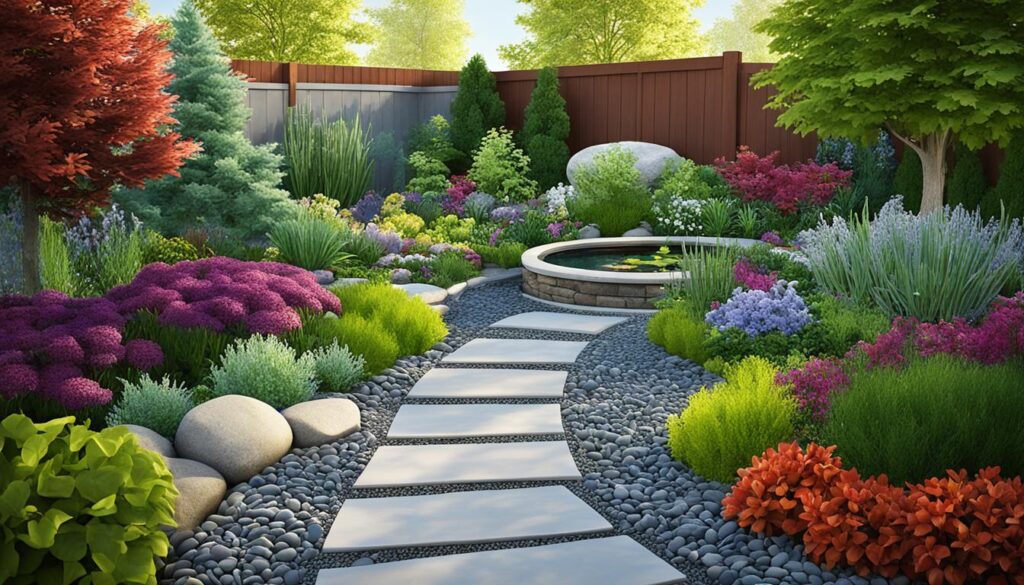
Check how weather affects your area, too. Maybe you need windbreaks for strong winds, or good drainage for rainy places. Every detail helps shape a successful garden.
Importance of considering the functionality you desire (entertainment, relaxation, vegetable gardening)
After understanding the environment, think about your garden’s purpose. Want a spot for fun get-togethers? Include open areas for people to mingle. If you’re after peace, add water features or hidden spots for quiet time.
Love fresh food? Make space for vegetables and herbs, focusing on sunny parts. This not only feeds you but also becomes a fun hobby.
Your outdoor space reflects you and your home. With these home gardening tips, create a garden that meets your needs. It becomes a part of your lifestyle.
Design Principles for Personalized Gardens
When talking about garden design, it’s key to see how it makes gardening better. A personal garden isn’t just lots of plants. It’s more about creating a unique mix that reflects you.
Overview of Basic Design Principles: Unity, Balance, Color, Texture, and Form
Unity is vital in garden design, linking different parts together smoothly. Balance brings stability, using either symmetrical or asymmetrical designs. Color affects feelings and how deep your garden looks.
Texture adds a rich feel visually and to touch. Form gives the garden its shape. These elements work together to shape your garden’s look.
How to Choose a Theme that Reflects Your Personal Style
Choosing a theme is like picking a frame that highlights your vision. It could be a flower-filled English garden or a minimalist Japanese Zen space. Make sure it matches your lifestyle and style.
Use native plants and green materials to be kind to the earth. This way, your garden is beautiful and good for the planet.
I’m here to help you create a garden that shows who you are. Starting this journey can turn your garden into a soul-soothing place. Watch as your green space starts to mirror your inner self.
Selecting Plants and Materials
My journey into sustainable gardening focuses on picking the right plants and materials. It’s crucial for creating a garden that not only looks good but also thrives. Let me help you make your garden flourish in tune with nature.
Guide on choosing plants that thrive in your specific environment
Understanding the variety of plants is essential for a vibrant garden. Think about your area’s climate, soil, and pests when choosing plants. It’s important to pick plants that fit well with your environment. This often includes native plants which need less water and care.
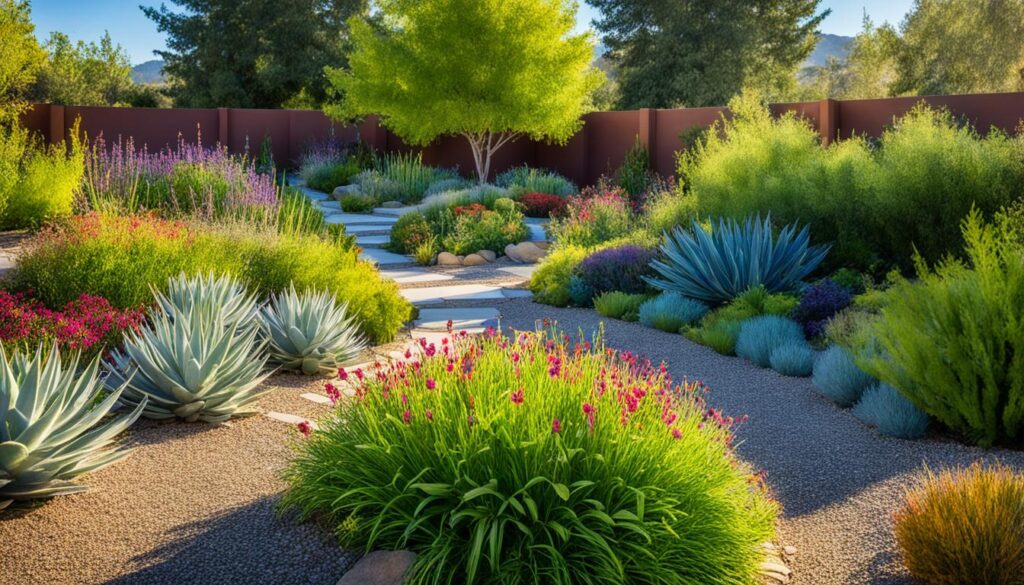
Also, think about where the sun shines in your garden. Plan where to place your plants so they get the right amount of sunlight. This careful planning helps your garden grow strong and healthy.
Recommendations for sustainable and attractive materials for landscaping
As you add plants to your garden, let’s focus on sustainable materials for its structure. There are many eco-friendly options like reclaimed wood for beds and natural stone for paths. Here’s a quick guide:
| Material | Sustainability | Use in Garden |
|---|---|---|
| Reclaimed Wood | Eco-friendly, reduces demand for virgin timber | Raised beds, benches, trellises |
| Natural Stone | Durable, no synthetic processes | Pathways, borders, rock gardens |
| Recycled Metals | Long-lasting, repurposes waste materials | Garden edging, arbors, art features |
| Crushed Brick | Recycled content, permeable for drainage | Driveways, walkway fillings |
| Recycled Rubber | Utilizes old tires, prevents soil erosion | Mulching, play areas, stepping stones |
Using these materials helps your garden be sustainable and have a low impact on the environment. It’s about creating a garden that’s both beautiful and eco-friendly. This way, we care for our planet and make a garden that balances with nature.
DIY Garden Projects
Embarking on DIY garden projects can make your outdoor space better. It adds a personal touch to your garden. Imagine the life and color they can add to your green haven.
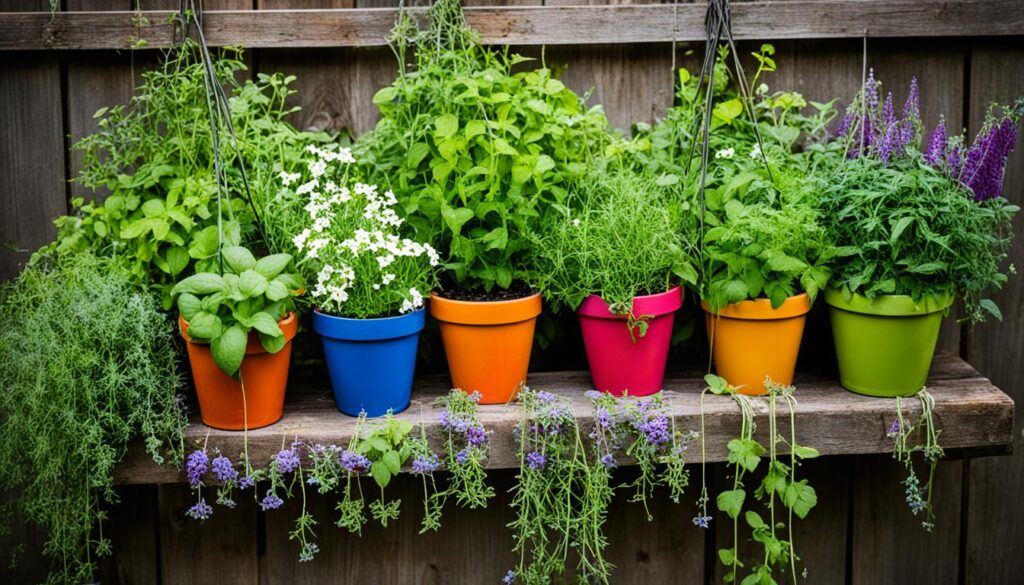
Building Raised Garden Beds
Building raised garden beds is a great project to start with. They help improve soil and drainage and look great. I’ll show you how to make them for successful gardening, whether you’re a pro or a newbie.
Creating Your Vertical Garden
Vertical gardens are great for saving space. They turn small areas into lush, productive gardens. By planning well, you can make stunning gardens that are also practical.
Installing a Simple Irrigation System
A simple irrigation system is a great final touch. It ensures your plants stay hydrated easily. With an efficient system, you save time and water, keeping your garden looking great.
Let’s work together to make your outdoor space a paradise. My advice is for everyone, whether you have a small balcony or a big yard. We’ll use innovation and style in our gardening solutions.
Seasonal Care and Maintenance
Year-round dedication is key to a thriving garden. You need great seasonal gardening tips. When working on garden planning and layout, include ongoing plant care methods. Let’s give our plants the best care throughout the year.
Tips for maintaining a garden through the seasons to ensure year-round beauty.
Each season makes your garden special but comes with challenges. Spring’s growth to winter’s rest needs different care. Here are important tasks for each season to keep your garden beautiful:
- In spring, clean the garden, trim back old growth, and refresh beds with mulch and compost.
- The summer needs more water for plants, frequent weeding, and keeping pests away in the heat.
- In autumn, clear fallen leaves, split perennials, and plant bulbs for spring.
- Winter is about protecting plants from cold, pruning them, and planning for spring gardening.
Pruning, fertilizing, and protecting plants from pests and diseases.
Keeping your garden healthy is crucial. Pruning shapes plants and encourages growth. Fertilizing gives vital nutrients, needed at growth start or when plants look weak.
Protecting your garden from pests and diseases is ongoing. Use organic methods or treatments to keep plants well. Regular checking helps deal with problems early and effectively.
Advanced Techniques for Experienced Gardeners
Let’s explore sustainable gardening practices that can transform your garden. I’ll share advanced gardening techniques to make your landscape design stand out. These methods are good for the planet and make your garden look better.
Vertical Gardening: Sky-high Greenery
Think about a garden that grows up, not just out. That’s vertical gardening. It’s perfect for those who have more imagination than space. By letting your greenery climb and hang, you make your garden more interesting. Your garden walls and trellises become the backdrop for your plants.
Hydroponics: Soil-less Growth Innovation
Hydroponics lets plants grow in water instead of soil. This cool method saves space and water. Plus, it makes plants grow faster. It’s a step forward in sustainable gardening practices.
Xeriscaping: Drought-Resilient Landscapes
Xeriscaping is about making a garden that can handle dry weather. It uses plants that don’t need much water. This approach is smart and makes your garden both beautiful and tough. It’s a clever way to have a gorgeous garden that’s easy to take care of.
| Technique | Key Advantages | Considerations |
|---|---|---|
| Vertical Gardening | Space-efficient, aesthetic appeal, versatile designs | Structural support, light access |
| Hydroponics | Water conservation, faster growth, fewer pests/diseases | Nutrient solution management, initial setup cost |
| Xeriscaping | Drought-resistance, low maintenance, water efficiency | Appropriate plant selection, soil amendment |
By using these advanced gardening techniques, you do more than just grow plants. You’re helping the Earth. These methods change the way we think about gardens. And they promise a greener future for everyone.
Garden Personalization Ideas
Making our gardens a reflection of us gives a deep connection to our outdoor areas. I think that garden personalization is key in turning these spaces into creating garden sanctuaries. These reflect our inner self. By blending beauty with useful design, we aim to make a space. This space should feel peaceful and reflect our personal style.
Envisioning Your Themed Garden
Themed gardens let us express ourselves in unique ways. Maybe you love a Victorian garden’s elegance, or a Zen place’s calm, or a fairy-tale’s magic. Themes let us show off our creative side. Think about which theme fits your style and how to bring it to life outside.
Harmonizing with Color Coordination
Colors can trigger feelings and create a vibe in your garden. A good color scheme makes everything look united and boosts your garden’s feel. Choose plants and decorations with colors that match well. This makes your garden visually pleasing.
Integrating Special Features
Adding things like water features or sculptures makes your garden stand out. A calm fountain or an art piece can be talking points. They also make your garden’s theme clear and provide a peaceful setting.
| Garden Element | Idea for Personalization | Impact on Sanctuary |
|---|---|---|
| Pathways | Custom stepping stones with personalized designs | Adds a touch of personal history, leading you through your own story |
| Planters | Repurposed items that reflect personal hobbies or interests | Infuses the garden with personal character and sparks conversation |
| Seating | Bespoke benches or swings fitted to favorite garden spots | Encourages relaxation and personal retreat within nature |
| Flower Beds | Selection of flowers that create a personalized color scheme | Enhances mood and makes each view a painted canvas of your emotions |
The chances to personalize your garden are endless. Every choice shows a bit of my path and likes. By carefully creating garden sanctuaries, we make a peaceful spot. This spot feeds our soul. It’s our personal ideals shown through landscape design.
Tools and Resources
For anyone passionate about gardening, having the right tools and resources is key. This is true whether you’re starting a small herb garden or creating a big landscape. Here are some fundamental gardening tips and indispensable items for plant care and landscape design.
Essential Gardening Tools and Resources for Beginners to Experts
As your gardening skills grow, you’ll see that some tools are essential. From the simple trowel to more complex landscaping tools, the right gear can greatly enhance your gardening experience. Below, we’ve listed essential tools along with invaluable resources to help you in creating your gardening masterpiece.
| Tool | Use | Recommended For |
|---|---|---|
| Trowel | Planting, Scooping soil, Weeding | Beginners, Container gardens |
| Pruners | Trimming plants, Pruning bushes | Intermediate gardeners, Rose enthusiasts |
| Garden Fork | Aerating soil, Breaking up clumps | Beginners to Intermediate, Vegetable gardeners |
| Spade | Edging, Creating beds, Moving dirt | Advanced gardeners, Landscape designers |
| Rake | Clearing debris, Spreading mulch | All gardeners, Lawn maintenance |
| Wheelbarrow | Transporting materials, Mixing soil | All levels, Large gardens |
| Hose with Spray Nozzle | Watering, Cleaning tools | All gardeners, Water-wise landscapes |
To complement your toolkit, tapping into educational resources is a must. Online forums, local gardening clubs, and extension services offer great advice and a sense of community. Books like “The Vegetable Gardener’s Bible” by Edward C. Smith and “Designing the New Kitchen Garden” by Jennifer R. Bartley provide deep insights into plant care and landscape design. Remember, learning from fellow plant lovers is as important as having a good spade!
Conclusion
We’ve learned a lot about making your garden special. It’s not just about looking good. Your garden is a peaceful place for relaxing. It’s where you can enjoy being outside a lot. Plus, making your garden beautiful helps nature and makes you feel good.
A study shows why different plants in gardens matter a lot. Gardens help keep the Earth healthy, give us food, and protect nature. For example, gardens in southern Ethiopia face challenges but also help secure food for people.
Talking about gardens in the Amazon and parks in cities, we see their big role. They clean the air and help with the climate. Even green spots in cities add to nature and boost gardening, like in Dubbo, Australia.
But, gardens are more than being useful. They let us show who we are and enjoy outdoor life. Working in gardens boosts our self-esteem and health. It makes us feel social and active. So, gardens are not just pretty. They’re places where we grow strong and happy.
In the end, gardens are much more than what we see. They’re safe havens and spots for creativity. They help us take care of life in its many forms. Gardens show how nature and people can work together. They bring peace and show how we can live in harmony with our planet. Let’s value these special spaces right outside our homes. They celebrate both worldwide care for nature and personal peace.
Call to Action
We’ve explored how to make your garden yours. Now, I invite you to take another step. Your outdoor space can turn into a tranquil, beautiful retreat. You have what it takes to make this happen. Join other enthusiasts and get tips to keep your garden a perfect spot for relaxation.
Unlock a Wealth of Gardening Tips
Join our YouTube channel @gardeningTLC for endless inspiration. Our videos offer smart gardening tips and fresh ideas. Whether you’re pruning roses or planning a landscape, we’ve got you covered. Stay updated and make your garden a stunning outdoor area, showing your dedication and love for nature. Get Your Passion Flowing and Watch what You Create!
Join the Conversation at “growingourgarden.com”
Also, check out growingourgarden.com for helpful gardening articles. It’s your chance to be part of a community. Share stories, get advice, and meet others who love gardening as much as you do. Joining can help you grow as a gardener and support a network passionate about beautiful, sustainable gardens.
Your garden’s transformation into a personalized haven is an ongoing journey. Knowledge and community support can guide you. Let’s look forward to making our gardens personal and delightful. Start these steps today for a more beautiful future.
FAQ
What is the purpose of personalizing my garden?
Making your garden personal turns it into a space that shows off your style. It becomes a peaceful spot to unwind and connect with nature.
How do I understand my garden space?
Start by looking at your garden’s light, soil, and weather conditions. Think about what you want it to be for, like hosting, chilling, or growing veggies.
What are the design principles for personalized gardens?
Key garden design ideas include keeping things together, balancing the look, using colors, textures, and shapes. Pick a theme that fits what you like.
How do I select the right plants and materials for my garden?
Choose plants that do well in your garden’s climate and soil. Also, go for landscaping materials that are both pretty and good for the planet.
What are some easy DIY garden projects?
Some simple garden DIYs are making raised planters, setting up wall gardens, and putting in watering systems. They make your garden look great and work better.
How do I maintain my garden throughout the seasons?
Keep your garden healthy by cutting back plants, feeding them, and keeping pests and sickness away. Do the right gardening jobs for each part of the year.
What are some advanced gardening techniques?
Some top gardening methods are growing plants up walls, water gardening without soil, and gardening with less water. These ideas make your garden stand out in cool ways.
How can I personalize my garden?
Make your garden yours by setting up themes, matching colors, and adding special touches like fountains or art pieces.
What are the essential gardening tools and resources?
Important gardening items are tools for planting, upkeep, and making your garden look nice. Helpful resources and online groups are great for extra help and ideas.
Why is personalizing my garden important?
Personalizing your garden creates a lovely space outdoors and a peaceful spot to relax.
How can I take further action in my gardening journey?
To keep learning and get more garden ideas, follow the YouTube channel “@gardeningTLC”. Check out “growingourgarden.com” for articles and to connect with other gardeners.
- 10 Must-Have Blooms for Your 2025 Garden
- The Health Advantages of Gardening You Need to Know
- How to Create a Small Vegetable Garden Layout Plan: A Beginner’s Guide
- DIY Garden Projects for Small Spaces: Upcycling Ideas to Maximize Your Garden
- Watering Techniques for Small Gardens: Ensuring Your Plants Thrive
- Small Border Plants for Landscaping: Adding Beauty and Functionality to Your Garden
- Year-Round Small Space Gardening: Seasonal Planting Tips for Maximum Harvest
- Essential Tools for Small-Space Gardening: What You Really Need
- The Ultimate Guide to Container Vegetables: What to Grow in Small Spaces
- Budget-Friendly Gardening: How to Create a Thriving Garden on a Tight Budget
- How to Optimize Sunlight in Small Gardens: Tips for Better Plant Growth
- DIY Vertical Planters: Creative Ideas for Small Space Gardening
- Companion Planting for Small Vegetable Gardens: Boost Growth and Deter Pests
- Container Gardening Essentials: Choosing the Right Pots, Soil, and Plants
- Vertical Gardening Techniques: Maximizing Your Small Space with Climbers and Vines
- How to Build a Raised Bed Garden in a Small Backyard: Step-by-Step Guide
- The Best Vegetables for Small-Space Gardens: High-Yield Varieties You Need to Grow
- Smart Vegetable Garden Layouts for Small Spaces: Maximizing Your Green Thumb in Compact Areas
- 40. Best Practices for Managing a Sustainable Garden Year-Round
- Building a Wildlife Pond for Biodiversity
- Advanced Techniques in Sustainable Gardening
- How to Create a No-Till Garden
- The Mental Health Benefits of Gardening
- Using Technology to Enhance Sustainable Gardening
- Getting Certified Organic: Steps and Benefits
